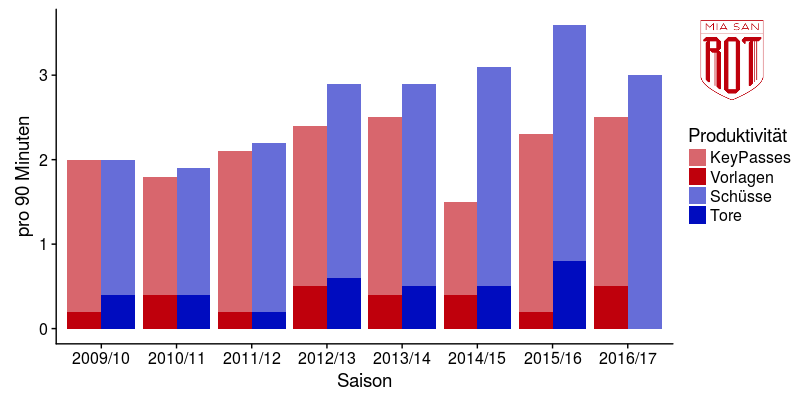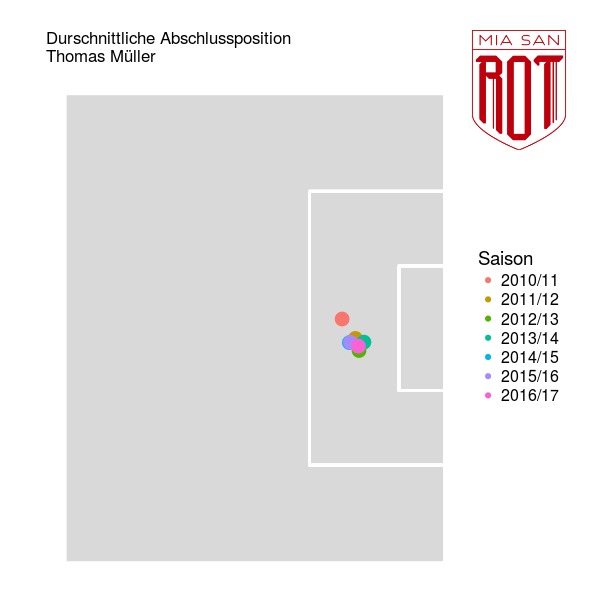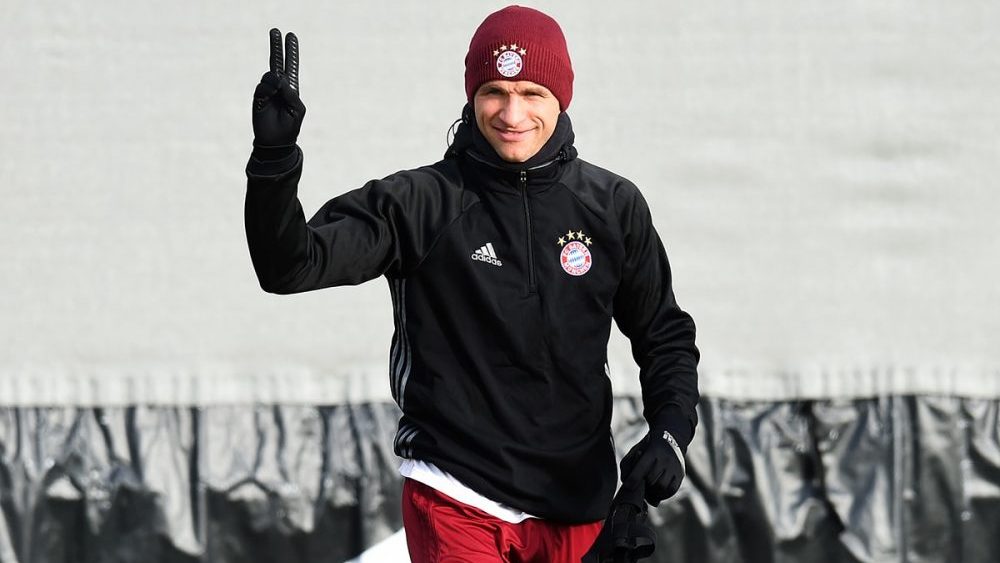Thomas Müller: Where is the actual problem?
In this analysis, I’m trying to convey a subjective impression that I will then examine with statistics. Statistics represent a part of reality and, through interpretation, enable to look at reality. In this analysis they’re important indicators for judging Thomas Müller’s performance.
Where is Thomas Müller & what is Ancelotti doing there?
For quite some time, Bayern fans have asked themselves who number 25 on the field is and what they have done to Müller. The forward looked unsure, suddenly missed penalties and couldn’t even hit a barn door anymore. In the Bundesliga, the German international hasn’t scored a single goal in 13 games. For many spectators the reasons were attributed to Müller not being involved enough when playing out wide.
Consequently, the 27-year old wouldn’t see much action inside the box, couldn’t get into many scoring opportunities and would be limited and wasted there. That the Bayern star is at his best when playing as a second striker in the centre has been shown once again when Bayern visited Mainz 05 recently. So why did Ancelotti field him on the unloved wing time and time again?
There are two logical arguments for this. For one, the Italian needed a winger, enabling him to rest his unfit dribblers and not burn them out again. Robben and Ribéry were sidelined for several weeks. Kingsley Coman, the third of the four wingers, is currently out and even Douglas Costa was injured for a while. All four weren’t out at the exact same time and Ancelotti could’ve switched to a 4-4-2 a few times but maybe it was too much of a gamble for him. On the other hand, albeit being better in the centre, Thomas Müller is probably not even that bad as an inside forward.
Barely any salience in cross-comparison
To clarify in advance, all statistics are from Bundesliga games only, because the competition allows to judge a form curve best.
Between the seasons 2009/2010 and 2015/2016, Thomas Müller had steadily increased his number of shots on goal. Back in the first season it had been two shots per 90 minutes, while he already recorded 3.6 in the past season. With 3 attempts per 90 minutes this season, he’s slightly above his average of 2.7.
Therefore, it’s interesting to take a look at how and from where Müller finishes. 2.6 of his 3 shots on target are taken inside the opposition’s box. That’s his joint career second-best, tied with the 2013/2014 season. Only in 2015/2016 did the international reach a higher number (2.8/90 minutes). This is yet another figure above his career average (2.2/90 minutes).
However, only one shot every 90 minutes is going on goal, which is remarkably low. The figures in the four previous seasons were 1.8/90 minutes, 1.6/90 minutes, 1.2/90minutes and 1.5/90 minutes. Only in 2010/2011 (0.9/90 minutes) and 2011/2012 (0.8/90 minutes) was it lower. In this category, Müller is ranking below his average with 1.2 shots on goal per 90 minutes.
Another small difference that is noticeable compared to the past is the type of his chances. With 0.8 headers every 90 minutes, the 27-year old currently has reached his second-highest average of his career. In the treble season, he took 1 header every 90 minutes. The figures weren’t that much lower in the previous years though. He’s averaging 0.55 per 90 minutes, which is lowered by the slim figures (0.2; 0.2; 0.4) from 2009 to 2012.
Furthermore, Müller is scoring by far most of his goals with his strong foot. On average 0.34 per 90 minutes, while he scores 0.14 goals per 90 minutes with either his left foot or his head. This is rather interesting, because in the current season he’s averaging 1.6 shots with his right – a figure that’s lower than in the three previous seasons. From 2009 to 2013, he recorded 1.4 and, in the following years, 2 per 90 minutes after all.

(Graphic: Lukas)
Rated when it comes to goalscoring, underrated when it comes to assists
Müller’s role at FC Bayern is an extremely important one. His involvement in shots on target solidifies that. Since 2009, he has only had one season where he was involved in less than 4 shots every 90 minutes (2010/2011; 3.7/90 minutes) – averaging more than 5 in the treble year (5.3/90 minutes) and in the past season (5.9/90 minutes).
As it currently stands, Müller creates 2.4 chances per 90 minutes (his career best). Adding his own shots, he’s involved in 5.5 direct scoring opportunities.
The German international is the club’s second-most important key passer after Ribéry (2.6 key passes/90 minutes) and ranks third in shots on goal behind Arjen Robben (3.1/90 minutes) and Robert Lewandowski (4.4/90 minutes).
He certainly hasn’t lost his ability to provide assists. The 27-year old currently assists 0.5 goals per 90 minutes.
Unmeasurable flaws in the game
Going by statistics, Müller’s season isn’t even that bad. From that perspective it’s actually one of the best ones in his career. However, there are still obvious things that are hard to measure with statistics.
One can look at his passing accuracy (72%) and determine it’s the worst of his career. Only in 2014/2015 was he nearly as bad in that area (72.4%), while his average is around 77%.
Often it’s the loss of focus. Müller doesn’t seem to have cleared his mind and this argument surely is applicable when you’re looking at reasons for his goal drought. He’s bickering with himself, plays unusual bad passes and makes basic mistakes.
We’re only talking about small issues here. Small tweaks he has to make himself. For that he needs playing time and feelings of success. Ancelotti shares the same opinion, thus fields him repeatedly and rightly so.
Müller’s integration at FC Bayern
As mentioned before, the forward is a solid winger. He’s finding his own ways, opens space for his teammates and moves into the centre. A role that Ancelotti has defined for this wingers anyway.
The best example for that is the home game against Eindhoven. Müller moved inside and operated in the usually undermanned playmaker space.
Bayern’s number 25 is definitely not wasted on the wing. This is partly proven through the position of his shots, which has hardly changed.
The problem with Thomas Müller on the wing is not down to his own performance. With him moving inside, the position on the wing opens up and will be occupied by Philipp Lahm, Rafinha or Joshua Kimmich. All players that don’t provoke a one-on-one situation.

(Graphic: Lukas)
Bayern’s magical triangle
That the forward produces his best performances in the centre is out of question. With statistics or without, Müller’s performance against Mainz last weekend was a step forward. Subtracting two or three unfortunate losses of possession and adding more luck to his finishing, we’d have the Müller of the recent years.
Ancelotti’s decision, allowing Robben and Lewandowski to play in and around Müller’s proximity was a very good one. This triangle is pretty much unstoppable.
Müller played a backheel to Robben, crossed his runs with Lewandowski and always moved into the position which would help the most. If one assumes that Robben and Lewandowski didn’t always get along overly well, Müller is the mediator. The calming element for Bayern’s essential triangle.
| 2009/10 | 2010/11 | 2011/12 | 2012/13 | 2013/14 | 2014/15 | 2015/16 | 2016/17 | |
|---|---|---|---|---|---|---|---|---|
| Shots | 2 | 1,9 | 2,2 | 2,9 | 2,9 | 3,1 | 3,6 | 3 |
| Goals | 0,4 | 0,4 | 0,2 | 0,6 | 0,5 | 0,4 | 0,8 | 0 |
| Shot- Assists | 2 | 1,8 | 2,1 | 2,4 | 2,5 | 1,5 | 2,3 | 2,5 |
| Assists | 0,2 | 0,4 | 0,2 | 0,5 | 0,4 | 0,4 | 0,2 | 0,5 |
| Passes (%) | 33 (77%) | 31,7 (76,4%) | 39,1 (78,8%) | 36,9 (77,7%) | 41,6 (78,6%) | 36,9 (72,4%) | 40,5 (77%) | 40,7 (72%) |
There’s a quick conclusion. Statistics prove that Müller’s current form is much better than most would’ve expected. His obvious issues are of mental nature and should dissolve once he gets on a good streak again. The game against Mainz was an important step in that direction.









